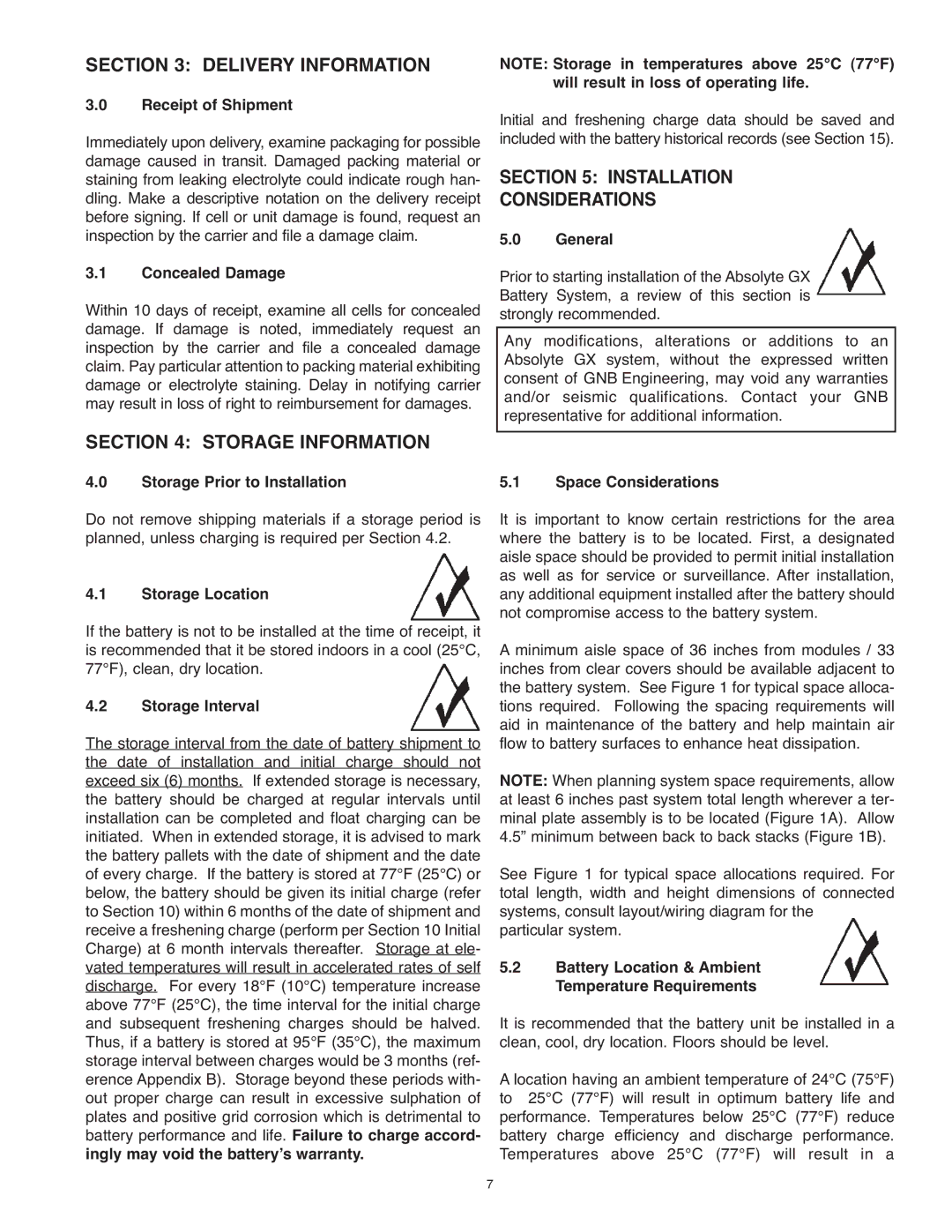
SECTION 3: DELIVERY INFORMATION
3.0 Receipt of Shipment
Immediately upon delivery, examine packaging for possible damage caused in transit. Damaged packing material or staining from leaking electrolyte could indicate rough han- dling. Make a descriptive notation on the delivery receipt before signing. If cell or unit damage is found, request an inspection by the carrier and file a damage claim.
3.1 Concealed Damage
Within 10 days of receipt, examine all cells for concealed damage. If damage is noted, immediately request an inspection by the carrier and file a concealed damage claim. Pay particular attention to packing material exhibiting damage or electrolyte staining. Delay in notifying carrier may result in loss of right to reimbursement for damages.
SECTION 4: STORAGE INFORMATION 4.0 Storage Prior to Installation
Do not remove shipping materials if a storage period is planned, unless charging is required per Section 4.2.
4.1 Storage Location
If the battery is not to be installed at the time of receipt, it is recommended that it be stored indoors in a cool (25°C, 77°F), clean, dry location.
4.2 Storage Interval
The storage interval from the date of battery shipment to the date of installation and initial charge should not exceed six (6) months. If extended storage is necessary, the battery should be charged at regular intervals until installation can be completed and float charging can be initiated. When in extended storage, it is advised to mark the battery pallets with the date of shipment and the date of every charge. If the battery is stored at 77°F (25°C) or below, the battery should be given its initial charge (refer to Section 10) within 6 months of the date of shipment and receive a freshening charge (perform per Section 10 Initial Charge) at 6 month intervals thereafter. Storage at ele- vated temperatures will result in accelerated rates of self discharge. For every 18°F (10°C) temperature increase above 77°F (25°C), the time interval for the initial charge and subsequent freshening charges should be halved. Thus, if a battery is stored at 95°F (35°C), the maximum storage interval between charges would be 3 months (ref- erence Appendix B). Storage beyond these periods with- out proper charge can result in excessive sulphation of plates and positive grid corrosion which is detrimental to battery performance and life. Failure to charge accord- ingly may void the batteryʼs warranty.
7
NOTE: Storage in temperatures above 25°C (77°F) will result in loss of operating life.
Initial and freshening charge data should be saved and included with the battery historical records (see Section 15).
SECTION 5: INSTALLATION
CONSIDERATIONS
5.0 General
Prior to starting installation of the Absolyte GX Battery System, a review of this section is strongly recommended.
Any modifications, alterations or additions to an Absolyte GX system, without the expressed written consent of GNB Engineering, may void any warranties and/or seismic qualifications. Contact your GNB representative for additional information.
5.1 Space Considerations
It is important to know certain restrictions for the area where the battery is to be located. First, a designated aisle space should be provided to permit initial installation as well as for service or surveillance. After installation, any additional equipment installed after the battery should not compromise access to the battery system.
A minimum aisle space of 36 inches from modules / 33 inches from clear covers should be available adjacent to the battery system. See Figure 1 for typical space alloca- tions required. Following the spacing requirements will aid in maintenance of the battery and help maintain air flow to battery surfaces to enhance heat dissipation.
NOTE: When planning system space requirements, allow at least 6 inches past system total length wherever a ter- minal plate assembly is to be located (Figure 1A). Allow 4.5” minimum between back to back stacks (Figure 1B). See Figure 1 for typical space allocations required. For total length, width and height dimensions of connected systems, consult layout/wiring diagram for the particular system.
5.2 Battery Location & Ambient
Temperature Requirements
It is recommended that the battery unit be installed in a clean, cool, dry location. Floors should be level.
A location having an ambient temperature of 24°C (75°F) to 25°C (77°F) will result in optimum battery life and performance. Temperatures below 25°C (77°F) reduce battery charge efficiency and discharge performance. Temperatures above 25°C (77°F) will result in a
